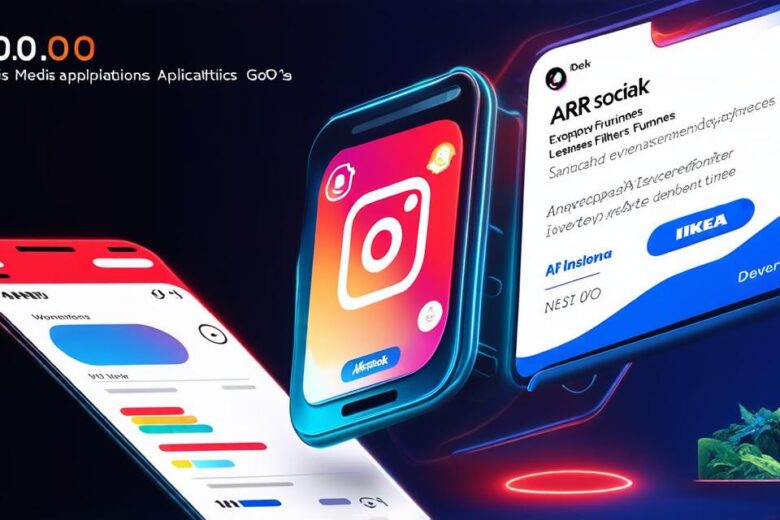Introduction:
Augmented reality (AR) technology is transforming the way people interact with digital content and each other. AR applications have gained popularity among businesses, organizations, and individuals looking to enhance their social media presence. In this article, we will explore examples of AR applications in social media platforms and how they can help AR developers create innovative and engaging experiences for their users.
1. What are Augmented Reality Applications in Social Media Platforms?
AR applications in social media platforms allow users to experience digital content in a real-world environment. These applications use computer vision algorithms, sensors, and other technologies to overlay digital information onto the physical world. AR social media platforms can be accessed through smartphones or tablets and offer a range of features such as virtual try-on, geolocation-based experiences, and interactive games.
2. Examples of Augmented Reality Applications in Social Media Platforms:
a) Instagram Filters: Instagram filters are one of the most popular AR applications on social media platforms. These filters use computer vision algorithms to analyze user faces and apply digital effects such as facial hair, glasses, or masks. The result is a personalized and engaging experience that encourages users to share their photos with their followers.
b) Snapchat Lenses: Snapchat lenses are another popular AR application in social media platforms. These lenses use the camera on smartphones to overlay digital effects such as filters, animations, or 3D objects onto real-world environments. Users can customize these effects using a variety of options and share their experiences with friends and followers.
c) Pokemon Go: Pokemon Go is a popular AR mobile game that has taken the world by storm. The game uses GPS technology to allow users to catch virtual creatures in real-world environments. It has been praised for its engaging gameplay, social aspects, and ability to encourage physical activity.
d) IKEA Place: IKEA Place is an AR application that allows users to visualize furniture in their homes before purchasing. Users can place 3D models of furniture into their homes using the camera on their smartphones and see how it looks and fits in the space. This application has been praised for its ability to help users make informed decisions when buying furniture and reduce the number of returns.
e) TikTok Effects: TikTok effects are another example of AR applications in social media platforms. These effects use computer vision algorithms to analyze user movements and apply digital effects such as filters, animations, or 3D objects onto real-world environments. Users can create and share their own effects using a variety of options, making the platform highly engaging for both creators and viewers.
3. How AR Applications in Social Media Platforms Benefit AR Developers:
a) Enhanced User Experience: AR applications in social media platforms offer an enhanced user experience that encourages users to engage with the content more deeply. This engagement can lead to increased social sharing, higher click-through rates, and ultimately, better conversion rates for businesses.
b) Increased Creativity: AR social media platforms provide a platform for users to express their creativity and share their ideas with the world. This can inspire other developers to create new and innovative AR applications that push the boundaries of what is possible.
c) Improved Analytics: AR social media platforms offer valuable analytics data that can help businesses understand how users are interacting with their content. This data can be used to optimize marketing campaigns, improve product design, and ultimately, increase revenue.
d) Reduced Development Time: By leveraging the power of existing AR development tools and platforms, developers can reduce the time it takes to create new AR applications. This allows businesses to quickly innovate and stay ahead of the competition.
4. Best Practices for Creating AR Applications in Social Media Platforms:
a) Keep it Simple: AR applications should be easy to use and navigate, with clear instructions on how to interact with the content. Users should be able to understand the value proposition of the application within a few seconds of using it.
b) Make it Personalized: Users are more likely to engage with AR applications that are personalized to their interests and preferences. Developers should use data analytics to understand user behavior and tailor the experience to each individual user.
c) Optimize for Mobile: AR social media platforms are primarily accessed through mobile devices, so developers should optimize their applications for these platforms to ensure a seamless user experience.

d) Test and Refine: Developers should test their AR applications with a wide range of users to identify any issues or areas for improvement. They should also be willing to refine their applications based on user feedback to ensure the best possible user experience.
Summary:
Augmented reality technology is transforming the way we interact with digital content and each other. Augmented reality applications in social media platforms offer a powerful tool for businesses, organizations, and individuals looking to enhance their social media presence. By leveraging the power of AR, developers can create innovative and engaging experiences that encourage users to engage more deeply with their content. As the world continues to embrace augmented reality technology, we can expect to see even more exciting applications in social media platforms in the future.
